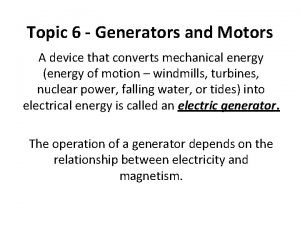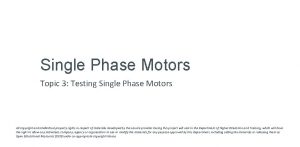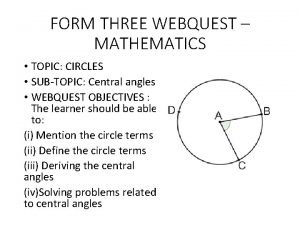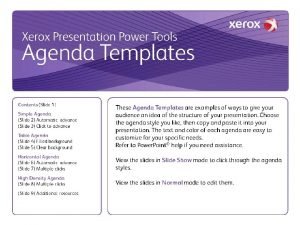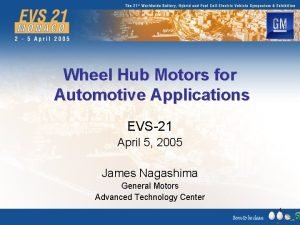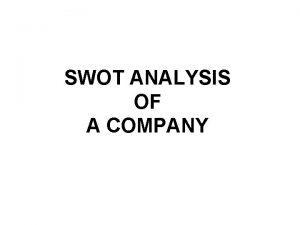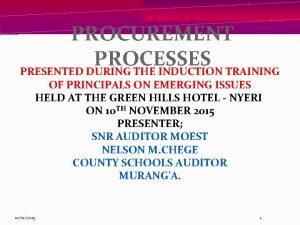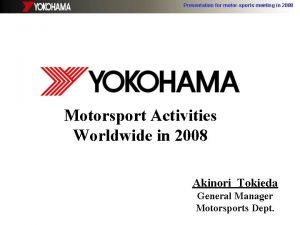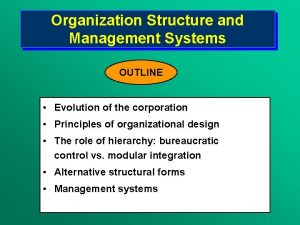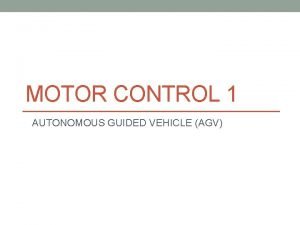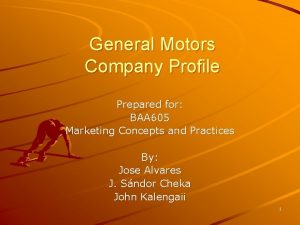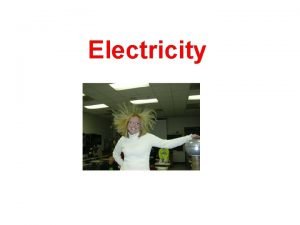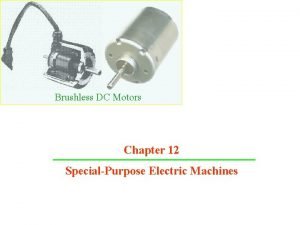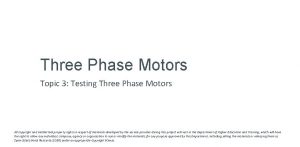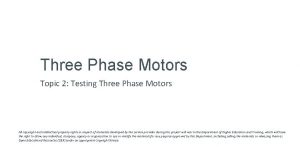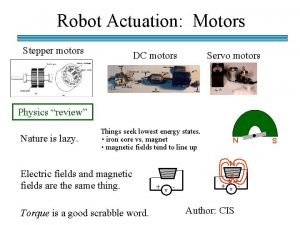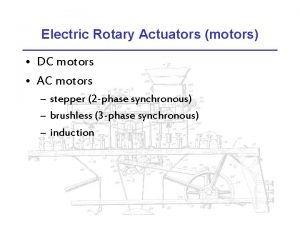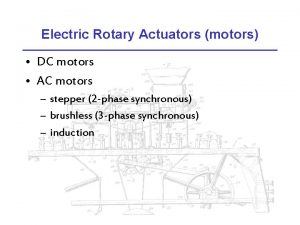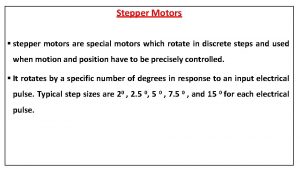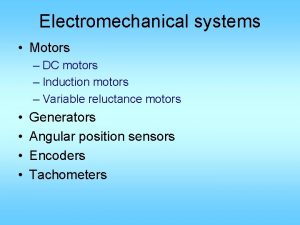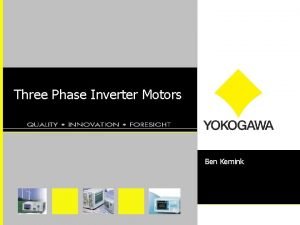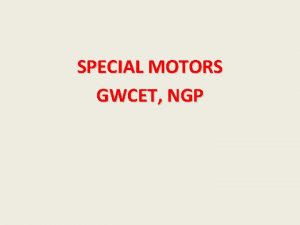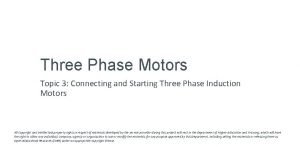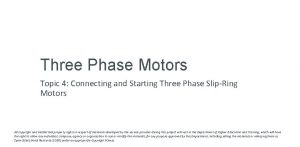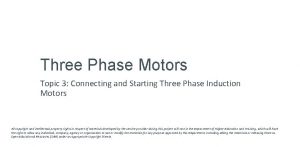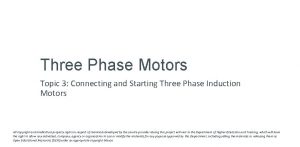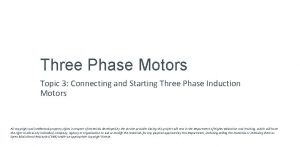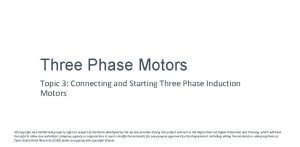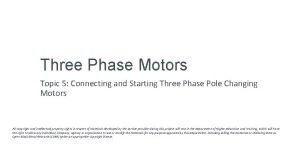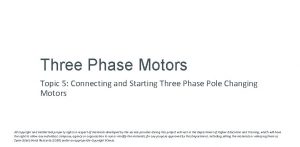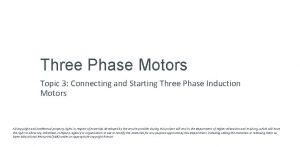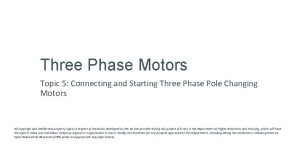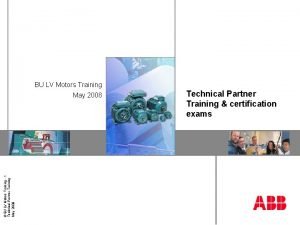Three Phase Motors Topic 1 How Three Phase





























- Slides: 29

Three Phase Motors Topic 1: How Three Phase Motors Work All copyright and intellectual property rights in respect of materials developed by the service provider during this project will vest in the Department of Higher Education and Training, which will have the right to allow any individual, company, agency or organisation to use or modify the materials for any purpose approved by this Department, including selling the materials or releasing them as Open Educational Resources (OER) under an appropriate copyright license.

Assumed prior learning

Outcomes By the end of the unit you will be able to:

Unit 1. 4: Synchronous Speed and Slip

Introduction Remember this question we asked in unit 2 of this topic? What would happen if the rotor of an induction motor were to spin at the same rate as the rotating magnetic field of the stator? Remember 1 It is the rotating magnetic field of the stator cutting the rotor bars that induces a current in the rotor bars. 2 It is this induced current that creates a magnetic field on the rotor that then tries to follow the stator.

Why the rotor is always slower If the rotor spins at the same rate as the stator rotating magnetic field then there is… Click the numbers to read more. 1 No relative motion between the rotating field and rotor 2 No relative motion means no induced current in the rotor bars. No inducted current means the rotor is no longer an 3 electromagnet. 4 This means that there will be no force to spin the rotor and the rotor will slow down again restoring relative motion.

Synchronous speed We call the speed at which the stator magnetic field rotates synchronous speed. We calculate the synchronous speed of a motor with this equation. This equation gives us revolutions per minute (rpm). Img 01

A quick note on poles Most induction motors have 4 or 6 poles but some motors have 2 or 8 poles. But what exactly is a pole. Click on the image to learn more. Img 01 a

How does the equation work? Take a look at this motor. We can see that it has 2 poles per phase. What happens, if we supply the motor with 50 Hz AC power? How many times, per minute will the stator magnetic field spin round? Watch the video to see if you are right Img 01 b

Example 1 What is the synchronous speed of a 4 pole motor connected to 50 Hz three phase power? a) b) c) d) 50 rpm 1, 500 rpm 9. 6 rpm 1, 500 rps

Example 2 What is the synchronous speed of a 6 pole motor connected to 60 Hz three phase power? a) b) c) d) 60 rpm 12 rpm 1, 200 rpm 1, 300 rpm

Example 3 A motor is known to have a synchronous speed of 750 rpm when connected to 50 Hz power. How many poles does it have. a) b) c) d) 2 4 6 8

Example 4 A 2 pole motor is known to have a synchronous speed of 3600 rpm. What power source must it be supplied to have this synchronous speed? a) b) c) d) 50 Hz 55 Hz 60 Hz 65 Hz

Example 5 True or false: A 4 pole induction motor will have a higher synchronous speed the higher the frequency of the power supplied to it. a) True b) False

Example 6 If we wanted a 6 pole motor to run at a synchronous speed of 2, 800 rpm, what frequency would the power supplied to it need to be? Hz Submit

Slip We know, however, that induction motors cannot run at synchronous speed. They must always spin more slowly. The difference between synchronous speed NS and rotor speed NR is called slip and it is always expressed as a percentage of the synchronous speed. Img 02

To calculate a motor’s slip, we need its synchronous speed and its rotor speed. This information can be found on the motor nameplate.

Example 1 The nameplate speed of a 50 Hz, 4 -pole induction motor is 1440 RPM. Calculate the percentage slip. a) b) c) d) 3% 4% 5% 6%

Example 2 What is the slip of this 4 pole motor? a) b) c) d) 0. 8% 1% 2% 4%

Example 2 What is the slip of this 2 pole motor? a) b) c) d) 7% 8% 9% 10%

Example 3 A 4 pole 50 Hz motor has a known slip of about 5. 5%. What is its rotor speed? a) b) c) d) 7% 8% 9% 1490 rpm

Example 4 If this motor has a slip of about 6%, how many poles does it have? a) b) c) d) 4 3 2 8

Image Briefing – Img 01 Ns is the symbol we use for synchronous speed f is the frequency of the three phase power. In SA this is always 50 Hz. p is the number of poles per phase the motor has

Image Briefing – Img 01 a (1 of 3) 2 -pole, 3 -phase motor For each of the three phases there are 2 poles (or 1 pair of poles) that when energised produce an alternating N and S pole. This is a 2 pole motor. There are 6 poles altogether but only 2 poles per phase.

Image Briefing – Img 01 a (2 of 3) 4 -pole, 3 -phase motor For each of the three phases there are 4 poles (2 pairs of coils) that when energised produce an alternating N and S pole. This is a 4 pole motor. Each pair of coils is connected so that they are energised at the same time.

Image Briefing – Img 01 a (3 of 3) For each of the three phases there are 6 poles (3 pairs of coils) that when energised produce an alternating N and S pole. This is a 6 pole motor. The more poles a motor has the smoother it runs. 6 -pole, 3 -phase motor

Video Briefing – Vid 01 (1 of 2) Produce a screencast video with an expert electrician explaining how the synchronous speed equation works. Use images like those on next slide to aid the explanation. 1. 2. 3. 4. 5. 6. If the AC supply is at 50 Hz, it means that each phase repeats 50 times per second. In a 2 pole, three phase motor, looking at phase 1 (yellow), if the initial orientation is NS (top to bottom), half way through the cycle it will be SN (a 180° rotation)and at the end of the cycle it will be back to NS (a full 360° rotation). This repeats 50 times per second which means that the stator magnetic field will rotate 50 times per second. If it rotates 50 times per second, it will rotate 50 x 60 = 3000 times per minute. This is the Synchronous Speed given as Revolutions Per Minute. Look now at the 4 pole, three phase motor. If the initial orientation of the yellow phase is NS (top to bottom) then half way through the cycle it will have rotated 90°. After one full cycle it will have rotated 180°. It will take 2 full cycles to rotate a full 360°. Therefore, it will only make 25 full rotations per second or 25 x 60 = 1500 rotations per minute. The synchronous speed will thus be 1500 rpm. To make the second calculation look like the first one, we can change it to 50 x 60/2 or supply frequency times 60 all divided by 2. To make the first equation look like this, we can write it as 50 x 60/1 So we now have an equation that is supply frequency x 60 / number of pole pairs per phase. But motors are named

Video Briefing – Vid 01 2 -pole, 3 -phase motor 4 -pole, 3 -phase motor

Ns is still the symbol we use Image for Briefing – Img 02 synchronous speed S is the symbol we use for slip NR is the symbol we use for rotor speed Multiplying by 100 gives us an answer as a percentage
 Ac systems lesson 4
Ac systems lesson 4 Generators and motors
Generators and motors Testing single phase motors
Testing single phase motors Examples of clinchers
Examples of clinchers Narrowed down topic
Narrowed down topic Normal phase vs reverse phase chromatography
Normal phase vs reverse phase chromatography Hplc reverse phase vs normal phase
Hplc reverse phase vs normal phase Mobile phase and stationary phase
Mobile phase and stationary phase Stationary phase and mobile phase in hplc
Stationary phase and mobile phase in hplc Normal phase vs reverse phase chromatography
Normal phase vs reverse phase chromatography Line vs phase voltage
Line vs phase voltage Adsorption chromatography
Adsorption chromatography Phase to phase voltage
Phase to phase voltage Broad phase vs narrow phase
Broad phase vs narrow phase What is the topic of the song
What is the topic of the song Topic two
Topic two Hollingshead motors
Hollingshead motors Wheel hub motors for automotive applications
Wheel hub motors for automotive applications Et 600 gate motor troubleshooting
Et 600 gate motor troubleshooting Tata motors introduction
Tata motors introduction Mashima motor
Mashima motor Induction motors procurement
Induction motors procurement Podium motors
Podium motors General motors organizational structure
General motors organizational structure Agv stepper motors
Agv stepper motors Baa motors
Baa motors How does a motor work
How does a motor work Corporate strategy of tata motors
Corporate strategy of tata motors Which type of plan shows the layout of hvac system
Which type of plan shows the layout of hvac system Special purpose motors
Special purpose motors

